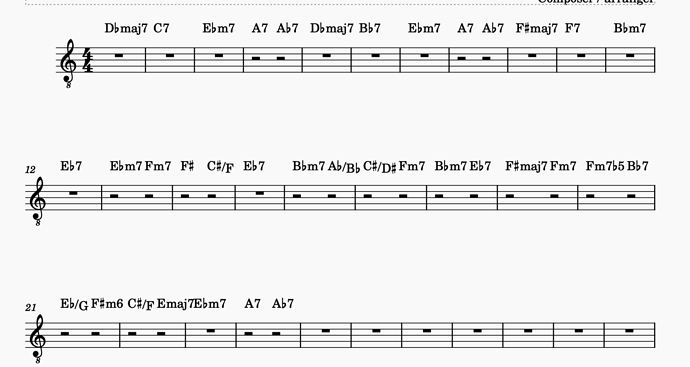Oh, hey! Only just seeing this now.
I highly recommend soundslice to simplify workflow. One window for audio + notation. Small learning curve. Corey just put up a new demo here . You can see videos of me transcribing with it here and here.
And more misc. transcriptions at my soundslice channel, here.
(This is assuming you want to document/write down what you’re transcribing. If you’re not going to write anything down, soundslice’s advantage isn’t as significant.)
I could comment on this just that it depends on what your goal is with the transcription. I’d say in general it’s good to be able to notate things, but the priority level depends on a lot of factors. For whatever it’s worth, when I’m struggling with something (especially rhythmically) I like to write it down so that I don’t have to just keep hoping I’ll remember.
I guess I could argue there’s a push pull because let’s say for the same quantity of music, the more you write down, the less you have to use your ears, but the faster you’ll produce a finished, playable product, and also the more accurate the transcription will be. The less you write down, the more you have to internalize the vocabulary/concepts (which is a good thing) but if the goal is simply to be able to play verbatim the thing you’re listening to, in the end this could take a lot more time and be a lot less accurate, assuming the vocabulary in the clip is stuff that’s challenging for you.
Do yous use headphones when listening to the tracks?
Pretty much always. If there’s a very clear mix, and/or I’m only trying to figure out an instrument that’s a higher register, I might just use the speakers but pretty much never laptop speakers or iphone speakers unless it’s like a tin whistle or something.
Do you not have your guitar with you, and instead use a midi piano?
Basically neither. I’ll often have my guitar on my lap but find myself only using it if I’m not confident in something. Even then, since I’m inputting notation into soundslice, I usually have it set so that as I type in a note, the computer plays that note back. So if i enter the wrong note I’ll hear it right away.
Now, that part is more in the long-term skill department - through a combination of things I’ve worked on over the years, I’ve gotten pretty quick with simply just knowing what something is on a first listen. For a melodic line (one note at a time,) hearing groups of 3-4 notes is pretty simple and I usually can identify most sets/sequences on a first listen unless it’s something more dense or complicated.
But when you’re newer to all this and not confident you’re doing things correctly, I think it’s fine to check stuff on guitar, sing it, engage the midi playback, whatever, to be sure you’re hearing what you think you’re hearing.
With transcribing, it’s super easy to make mistakes and not realize you’re making mistakes. To that point, it’s funny that in that old Wes video I linked to earlier in this post, I actually got the very first note wrong. I just got it in my head that he was starting F to G and didn’t really check it enough times, and for some reason throughout the vid I just accepted that that was the note and it didn’t catch my attention until later.
Since I’m often transcribing stuff for lessons, and often teaching the same tunes, I’m very frequently forced to review transcriptions I’ve made and I’ll typically hear new things every time, or mistakes from earlier versions. Consider that, if I’m a “good” transcriber, and still able to find mistakes in my own transcriptions each time I go over them (whether they’re from yesterday or from 15 years ago) then when you’re new to it, there’s definitely just going to be tons of stuff you’re not going to be hearing correctly, tons of details you’ll inevitibly miss, etc. It’s just part of the nature of the whole thing; we can hear what we can hear. And a transcription is really only “done” when you just say “ok f*** it, this is probably good enough” because you can always go over it and over it and over it…
It’s up to you how accurate and detailed you want to be, for whatever purposes you’re getting into transcription.
By the way, a tip on building accuracy and building your ears in general: If you find there is a certain type of thing that’s much harder for you to transcribe accurately (maybe chromaticism, maybe larger chords, maybe lines with bigger intervals, maybe funk rhythms, etc) I think it’s useful to isolate that skill with some sort of more formal/structured ear training, programs like iwasdoingallright.com can be very good and useful.
Example: the first time I ever tried transcribing jazz guitar voicings I had absolutely no idea what I was listening for and basically had zero confidence in what 75% on the notes were. But at that time I hadn’t done much ear training with more basic things like triad inversions and other more basic 3 note chord structures, so hearing these rapidly moving, complex 4 note chords voiced with lots of slides, it was a bit futile. I needed more ammunition! Um, aural ammunication? (Band name?)
Do you run your audio files through any audio seperation software such as Spleeter, to try and extract the guitar tracks?
No but only because I’m not really familiar, haven’t dabbled. I do often use EQ and panning to try to dig into what I want more.
Hope that helps!



